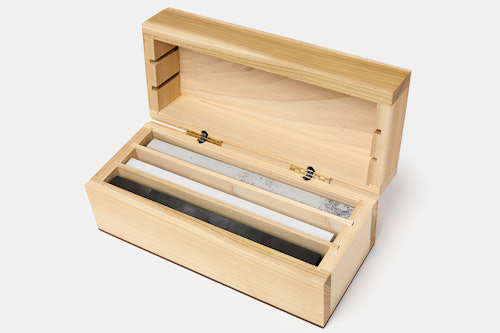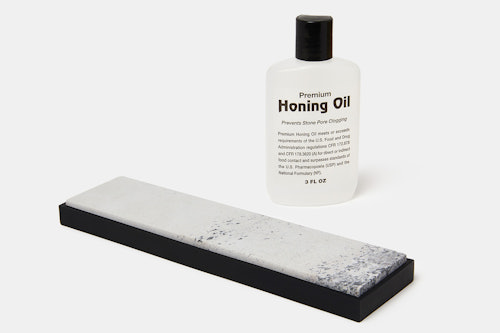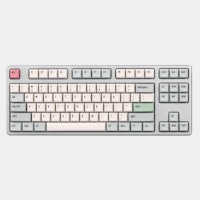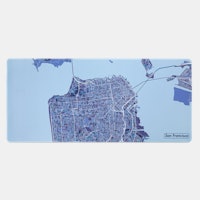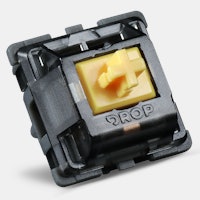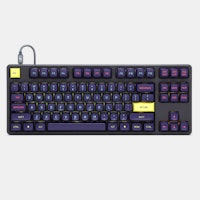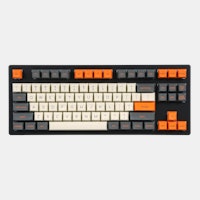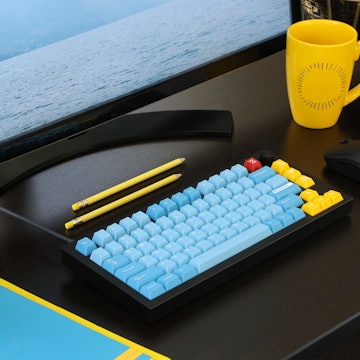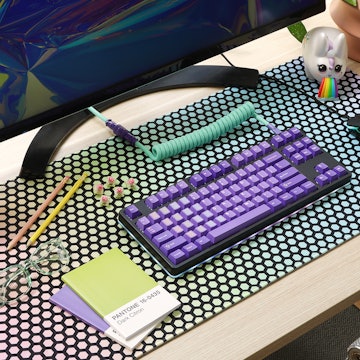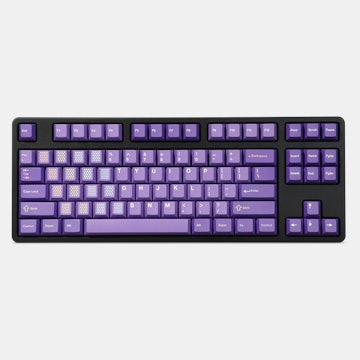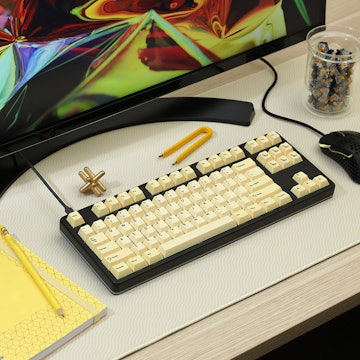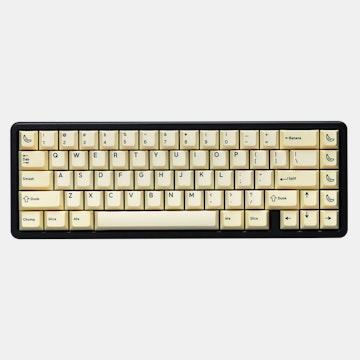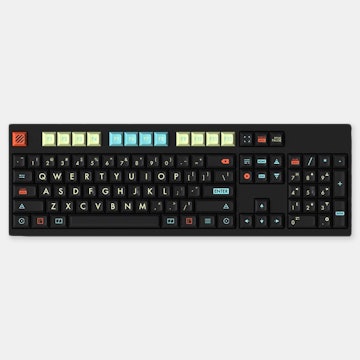Click to view our Accessibility Statement or contact us with accessibility-related questions




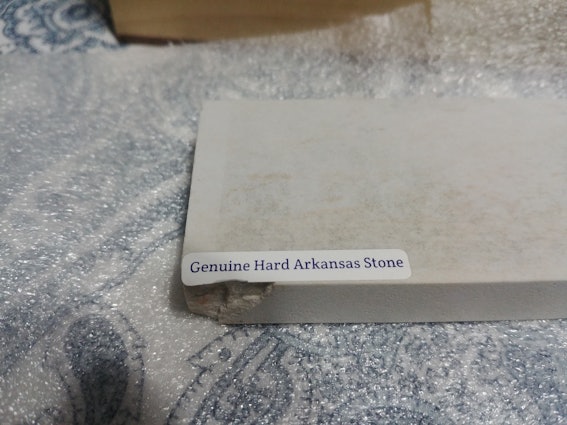













RH Preyda Sharpening Kit – Drop Exclusive
RH Preyda Sharpening Kit – Drop Exclusive
bookmark_border
Where's the price?
To negotiate the best possible price for our customers, we agree to hide prices prior to logging in.
455 requests
Product Description
The folks at RH Preyda know their way around sharpening stones. In fact, they quarry an abundance of 100-percent natural Arkansas stones by hand to ensure it meets their—and your—high standards Read More

search
close
Sort by: Newest
keyboard_arrow_downThetruth
0
Feb 1, 2021
"the stones are a little larger to make things easier" they're only 8 inches long...lmao who they trying to fool at $90?

Dermott
267
Feb 3, 2021
Thetruth6x2", 8x2", and 8x3" are pretty normal sizes for Arkansas stones, and length matters a bit more than width. 8" isn't a bad size at all.
Lion's share of the price in a bundle like this is going to be the hard black stone... similar stones in this size on Amazon float in the $70 - 80 range.
If you don't need the hard black stone, you're better off buying the soft and hard stones a la carte. If you want the black stone, though, bundled deals like this can be great.
lolmaus
2
Feb 2, 2021
Why are you so mean? What's wrong with doing research on knife sharpening and sharing findings with people interested in knife sharpening?
PS You're username kinda contradicts your attitude.

Blacktoxic
16
Aug 16, 2019

Narq
915
Aug 29, 2019
BlacktoxicHow strange- I just found a corner chip that has a sticker on it that says, "Genuine Missing Piece of Hard Arkansas Stone." You don't think... no, couldn't be.
(Edited)

Blacktoxic
16
Jul 1, 2019
Does the kit clearly indicate which is the soft and hard white? I am assuming based on the pictures that the soft is the one that is white mixed with grey; while the hard white is the pure white slab.
Also, what do you guys recommend for general cleaning after each use? A lot of online search results refer to cleaning of old abused or glassed over stones instead of regular after use cleaning.
These are what I found so far for cleaning after use:
- Wipe off with a paper towel
- Add additional honing oil liberally to lift up the swarf and wipe down with a paper towel
- Wash with soap and water and scrub with a nylon brush to remove swarf.

ryanburbridge
5
Aug 10, 2019
BlacktoxicEach stone has a little sticker on it to indicate what they are. The sticker looks cheap and will definitely not last. But good enough till you find your own method of identifying them. 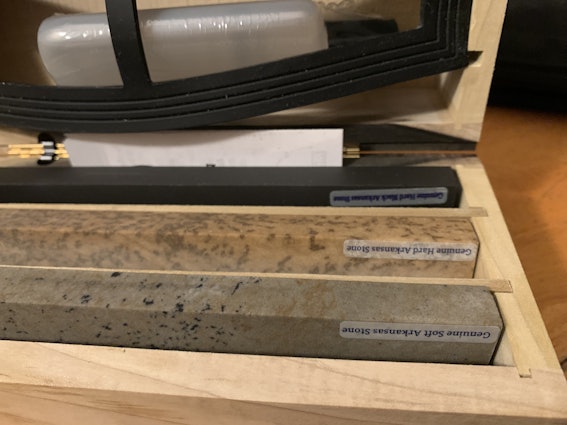
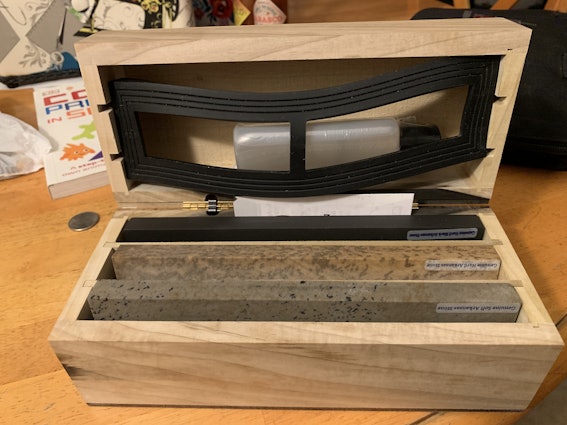



Dermott
267
Aug 11, 2019
ryanburbridgeOoooh, there's a rubber pad, and room for the bottle in the lid? That would have been great to include in the original drop photos. The rubber pad is a really nice touch; makes sharpening on a counter significantly easier.

Dermott
267
Jun 27, 2019
ryanburbridgePicture says "no".
ETA: it fits in the lid, as one of the later commentors showed, with a picture. I recant.
(Edited)

ryanburbridge
5
Aug 10, 2019
DermottJust received mine and everything fits in the case well. I took some of the packing and rolled them up and put them in the bottom of each row to help the stones stand up a bit above the case. They were a bit hard to get out when bellow the case dividers. All items still fit. I’m going to add a small latch to the outside of the box to keep it closed in case it gets knocked over but overall I’m happy. Now to start practicing my technique...
Logan5tx
97
Jun 27, 2019
I'm an admitted novice to sharpening, so I have a question for the experts. Would you typically use all sides of each stone in a typical session if you started from the 400 grit? I mean, would you start with 400, then go to 600-800-1000? Or would you go from say 400 to 800, or 600 to 1000? Or is it more important to progress through each 200 grit increment when you are at the lower ends?
I've got several pocket knives and 15 year old Wustof kitchen knives that have never been sharpened in the time I've had them. I decided to give it a shot and bought a cheap 120/240 grit stone. Watched a couple of youtube videos and gauged my angle with the folded paper trick. Then for the hell of it I honed them on the honing steel that came with the knife set (that I'd never used before) and then stropped on a leather strop that I used for my straight razors. I was pleasantly shocked at how sharp the knives got after trying this. They all easily sliced through tomatoes with little more than the weight of the blade so I was a very happy camper.
Not one to leave well enough alone, I kept watching videos and reading and seeing that lots of people keep sharpening up to the 800, past 1000, and of course the skies the limit. Now I'm second guessing my sharpness. Should I keep going with finer grit stones? If I was going to buy another combo stone, what grit would you recommend? Does the edge become less durable the higher you go? So many questions.

Dermott
267
Jun 27, 2019
Logan5txThe sides of the stone don't change the amount of grit. It doesn't matter which (wide) side of the stone you use. Don't use the edges.
The grit is expressed in a range, because Arkansas stones are a natural stone, and the cutting speed varies a bit from specimen to specimen.
In a typical session, you would start with the softest stone (lowest grit), and work up to the hardest (highest grit) stone. Depending on how dull the knife is, you may not start actually need to use the softer stones... if you're just touching up a kitchen knife, you'd just use the hard black stone. If you're sharpening a dull knife, you'd typically use the hard, then the hard black. If you have an exceptionally dull knife, or you're repairing a blade, you'd use all three.
For a pocket knife, or something that doesn't need to cut as finely as a kitchen knife, you may only use the soft and hard stones... just depends on what you're trying to achieve.
A 240 grit stone is faaaaaaar too coarse for your Wusthofs, unless you've been abusing the everloving crap out of them. I wouldn't typically go below the hard stone for a fine kitchen knife... My Wusthofs typically only touch the hard black stone. Hard stone on occasion, if I've been neglecting to sharpen them.
If you think they're sharp after a 240 grit stone, let me help you: they came dull out of the box. Sharpened properly (and these stones will do them properly, if you do your part) you can take the top off a tomato without supporting the tomato with your other hand, just like in the fancy-pants Japanese chef knife videos. It's fun.
Logan5tx
97
Jun 27, 2019
DermottHey thanks a lot, that’s a huge help! It didn’t even occur to me that those numbers were a range; that makes a whole lot more sense.
14themoney
1395
May 22, 2019
I have DMT Dia-Sharp stones. I can get my knives sharp enuf to shave and to push cut paper, but I am in the market for a guided system. (Something beyond a SSM or a WSKO, which I have.) I don't see how these offer any improvement over what I have. It's not like I have the palsy or feeling dreadfully hung over, but I am not sure that I can maintain a fixed angle for the time required. I have a hard white Arkansas stone, but I really don't use it much. I prefer my other sharpening systems. I have also heard that oil is not a good thing to use, because it will eventually clog up the stone. If anyone has any thots related to this, I would like to hear them. Thanx.

Dermott
267
May 22, 2019
14themoneyOil seems to help prevent the stone clogging, while it's in use. If you don't take soap and a brush to the stones, on occasion, they fill with metal particles and oil, and get glassy over time. That slows cutting pretty significantly, but it takes years of sharpening to really be an issue. These stones take a fair bit of abuse.
Arkansas stones tend to be a fair bit less expensive than decent diamond stones. Nothing wrong with diamond stones: they do the same job, and probably more quickly. They're just expensive, and they don't last as long. My dad used to wear out diamond stones in a couple years, sharpening chisels. Arkansas stones will last generations (I've got my granddad's old pocket stone). They're not fast, or fancy, but they're cheap, long-lasting, low maintenance, and they do the job.
What kind of flat rock (synthetic, water, Arkansas, diamond) you like really is just a matter of preference.

Dermott
267
May 22, 2019
The grits listed are borked, again. It'd be nice if someone that knew something about flat rocks would proof read before posting these.
The kit includes three Arkansas stones: a soft stone (400–600 grit), a hard white stone (8,000–10,000 grit), and a hard black stone (2,000–3,000 grit)
In order of coarseness, these stones are: soft, hard (here, called hard white), and hard black.
Relative grit info on Arkansas stone (regardless of manufacturer) can be found here: https://www.danswhetstone.com/information/stone-grades-101/
The soft stone is probably labeled correctly. Somebody added an extra zero to hard (should be 800-1000).
Hard to say, on the hard black stone, since they behave very differently from synthetic or water stones. A good hard black stone is fine enough for careful work as a straight razor hone.
(Edited)

Dermott
267
May 22, 2019
H.KMYeah... definitely the nicer kit. These are the larger (8x2" vs 6x2") stones, and this kit includes both honing oil (3oz will last an eternity) and the rubber stone holder. I've gotten by without a holder... but it makes things a heck of a lot easier for larger things, like kitchen knives.
Showing 37 of 63
Recent Activity

